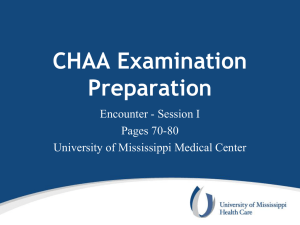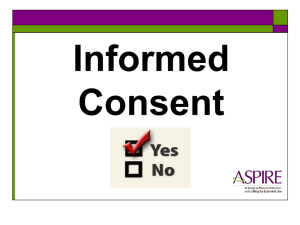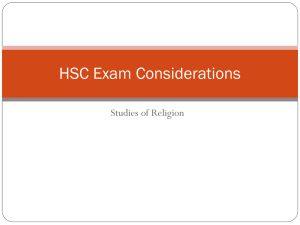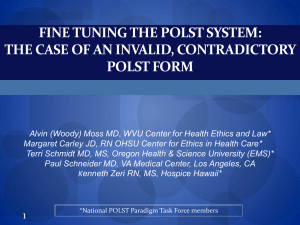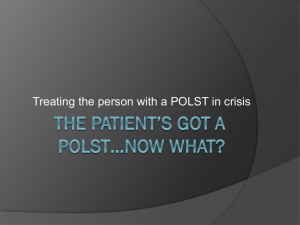The POLST Paradigm: Potential State Legal Barriers
advertisement
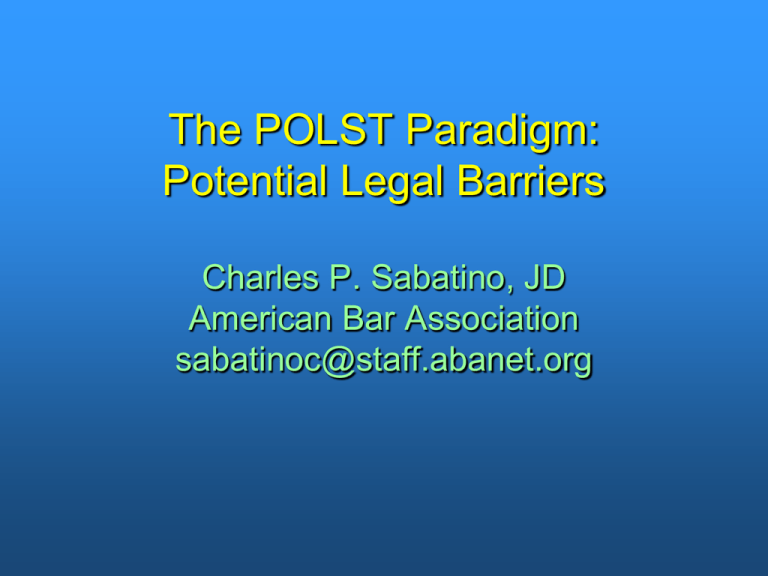
The POLST Paradigm: Potential Legal Barriers Charles P. Sabatino, JD American Bar Association sabatinoc@staff.abanet.org Potential Legal Barriers Study • Authors: Susan Hickman, PhD, Charles Sabatino, JD, Woody Moss, MD, and Jessica Nester, JD. • Support provided by: – – – – Oregon Health & Science Univ. Center for Ethics in Health Care National Hospice and Palliative Care Organization American Bar Association Commission on Law and Aging West Virginia University Center for Health Ethics and Law • Research identifies key potential legal and regulatory barriers to the POLST Paradigm in 50 states and DC Potential Legal Barriers Study Five Step Methodology: 1. E-mail to state EMS Directors and LTC contacts. 2. Telephone interviews. 3. Review identified potential legal barriers. 4. Analysis by law student, legal consultant and then co-investigator of following in all 50 States plus D.C: – – – – – – Living Will provisions. Durable Power of Attorney for Health Care Provisions. Default Surrogate Provisions. Non-hospital DNR provisions (statute and regulation) Guardianship law. State government web sites for DNR orders and/or POLST. 5. Barriers were summarized in Table and Appendix Terms • Advance directive statutes: living will statutes or statutes allowing people to appoint health care agents (sometimes referred to as health care proxy laws, or durable powers of attorney for health care). • Agent: person appointed by the patient. • Guardian: Any court appointed decision-maker with authority over health decisions. • ANH: Artificially supplied nutrition and hydration (e.g., food and water through tubes); does not include spoon feeding. Terms • DS: Default Surrogate = person or persons identified by state law with authority to act as surrogate decision-maker for an individual if there is no agent or guardian. • OHDNR: Out-of-Hospital DNR orders (also referred to as EMS-DNR Orders, or Comfort Care Orders, or CPR Directives) The term does not include rules for DNR orders for hospitals or other health care facilities. • Approved form: government approved, usually by state dept of health or emergency medical services program. • Forgoing: withholding or withdrawing. Terms • LST: Life-sustaining treatment, defined differently in statutes/regulations, but almost always includes CPR; treatment of ANH is less consistent. • N/A: not applicable because state does not have type of law at issue, e.g., no DNR protocol or no DS, no advance directive statute. • Patient: adult to whom treatment decision applies. • Substituted consent: consent for certain types of medical treatment when patient is not able to consent himself/herself. • Witness: usually must be adult with decision-making capacity. Eligibility requirements for serving as a witness are not spelled out in the Table. Introductory Issues • Who may consent to life-sustaining treatment including DNR? – Patient, agent/proxy, default surrogate, guardian – 39 states permit default surrogates to make EOL decisions – Rules may vary depending on decision-maker • Substituted consent to forgo LST or ANH: Limitations in AD, surrogate, or guardianship laws may limit POLST in certain circumstances. Introductory Issues • OHDNR Order Provisions – These exist in all but 4 states (MN, MS, MO,* ND) and represent a narrower template for the POLST concept, addressing only one intervention. – Their limitations and requirements can hamper the use of the POLST Paradigm. *MO subsequently enacted law. Findings: LST/ANH • 23 states (45%) impose explicit limitations on consent to forgo. – Most are diagnostic, e.g., terminal condition / PVS / end-stage condition – A few require witnessing – Limitation depends on whether the surrogate is appointed agent (12 states), default surrogate (20 states) or guardian (12 states) • 27 states impose some level of restriction where patient is pregnant Examples of medical conditions Terminal condition is the most common though inconsistently defined, e.g.— – So. Carolina: "Terminal condition" means an incurable or irreversible condition that within reasonable medical judgment could cause death within a reasonably short period of time if life sustaining procedures are not used. – Louisiana: "Terminal and irreversible condition" means a continual profound comatose state with no reasonable chance of recovery or a condition caused by injury, disease, or illness which, within reasonable medical judgment, would produce death and for which the application of life-sustaining procedures would serve only to postpone the moment of death. Examples Limits on Forgoing ANH: • Colorado: For DS only -- cannot consent to forgoing ANH unless “the attending physician and a second independent physician trained in neurology or neurosurgery certify in the patient's medical record that the provision or continuation of artificial nourishment or hydration is merely prolonging the act of dying and is unlikely to result in the restoration of the patient to independent neurological functioning.” • Ohio: Guardian and DS may forgo ANH only upon the issuance of an order of the probate court with several preconditions specified. Examples Limits on Forgoing ANH: • Oklahoma: No person has authority to forgo ANH except where: 1. The physician knows the patient gave “informed consent” to forgo ANH; 2. A court finds by clear and convincing evidence that the patient gave “informed consent” to forgo ANH; 3. The patient has a statutory advance directive authorizing forgoing of ANH; 4. ANH will cause “severe, intractable, and longlasting pain” or is not medically possible; or 5. The patient is in the final stage of a terminal illness or injury, but this exception is overridden if forgoing ANH “would result in death from dehydration or starvation rather than from the underlying terminal. Findings: OHNDR 6 States (IN, KS, MI, OK, PA, TX) prescribe detailed statutory form specifications. 2 states (RI, DC) require a specified bracelet/necklace be used. AR precludes w/h of treatments other than CPR. 33 states (65%) have form requirements deemed minimal or moderate. May require some modification of POLST to implement. • 15 states impose medical preconditions. • 12 states have witnessing requirements. Example of Highly Detailed Statutory OHDNR Form – KANSAS § 65-4942 A "do not resuscitate" directive shall be in substantially the following form: PRE-HOSPITAL DNR REQUEST FORM An advanced request to Limit the Scope of Emergency Medical Care I, ____________________, request limited emergency care as herein described. I understand DNR means that if my heart stops beating or if I stop breathing, no medical procedure to restart breathing or heart functioning will be instituted. I understand this decision will not prevent me from obtaining other emergency medical care by pre-hospital care providers or medical care directed by a physician prior to my death. I understand I may revoke this directive at any time. I give permission for this information to be given to the pre-hospital care providers, doctors, nurses or other health care personnel as necessary to implement this directive. I hereby agree to the "Do Not Resuscitate" (DNR) directive. ________________________________________ ______________________________ Signature Date ________________________________________ ______________________________ Witness Date I AFFIRM THIS DIRECTIVE IS THE EXPRESSED WISH OF THE PATIENT, IS MEDICALLY APPROPRIATE, AND IS DOCUMENTED IN THE PATIENT'S PERMANENT MEDICAL RECORD. In the event of an acute cardiac or respiratory arrest, no cardiopulmonary resuscitation will be initiated. ___________________________________ _____________________________________ Attending Physician's Signature * Date ___________________________________ _____________________________________ Address Facility or Agency Name Example of Highly Detailed OHDNR Statutory Specs District of Columbia § 7-651.04. Comfort care bracelet or necklace. (a) EMS personnel shall recognize only a comfort care bracelet or necklace for purposes of withholding cardiopulmonary resuscitation or advanced life support. (b) The Mayor shall approve the design for a comfort care bracelet and necklace. The bracelet and necklace shall be easily identifiable and designed so that the following information is visible: (1) The patient's name and an identification number; (2) The name and telephone number of the patient's attending physician; (3) The comfort care order number; and (4) Any other information that the Mayor determines, by rule, to be necessary to implement this chapter. (c) The comfort care bracelet and necklace shall be metal, except that the Mayor may issue a plastic temporary bracelet and necklace for use by a patient until the metal bracelet or necklace is received. Withdrawal of LST and Use of OHDNR Orders Standards/requirements may differ depending on: • Which law: OHDNR vs. Advance Directive law vs. DS law vs. Guardianship law. • Who the decision-maker is: Patient, Agent, DS, Guardian. • Setting: Hospital, LTC Facility, Home. Unanticipated Finding • Key contacts had great difficulty interpreting relevant state laws. • Interrelation of multiple laws affects options and procedures and adds confusion. – Answers from perspective of one law may be different from the perspective of another. Scope Limits of Study • If alternative preconditions include highly flexible option (e.g. burdens outweigh benefits), then no barrier noted. • OHDNR exceptions not considered (e.g. mass accidents, avoidance of conflict) • Some procedural elements not considered: procedure to certify of conditions, certifications that treatment not necessary for comfort care, notice to family. • Standards for decision-making not considered: substituted judgment/best interests, some more restrictive (clear and convincing) • Whether OHDNR preempts facility procedures. Scope Limits of Study • Restrictions on guardians -- Generally, their authority re health care is determined by the appointing court. Only restrictions noted are those expressly stated in guardianship, OHDNR, or advance directive law. • Living Wills -- Decisions to forgo LST based solely on a living normally require patient to be certified as being terminal or PVS. This limitation is not tracked on the chart. • Facility regulation -- Regulations applicable to particular kinds of facilities, such as nursing homes or assisted living facilities,are not tracked. Non-preemption Caveat • Most Advance Directive and OHDNR laws do not preempt any existing rights regarding health care decision-making authority or responsibility. • Rather, they are complimentary. • They include a carrot for providers: statutory immunity if complied with. • Thus, in most states, a reasonable argument can be made that since no law expressly precludes the POLST paradigm, it can be implemented based upon its clinical appropriateness. Non-preemption Examples OHDNR Law • IDAHO - Sections 56-1020 through 56-1035, Idaho Code, are cumulative to the existing law regarding an individual's right to consent, or refusal to consent, to medical treatment and do not impair any existing rights or responsibilities which a health care provider, a patient, including a minor, competent or incompetent person, or a patient's family may have in regard to the withholding or withdrawal of lifeprolonging medical procedures or any other health care decision-making under the common law or statutes of this state. Idaho Code §56-1032 • UTAH - Nothing in this part is intended to impair or supersede any other legal right or legal responsibility which a person may have to effect the withholding or withdrawal of life-sustaining procedures in any lawful manner. Utah Code Ann. §75-2-1117(4). Non-preemption Examples Advance Directive Law • FLORIDA - The provisions of this chapter are cumulative to the existing law regarding an individual's right to consent, or refuse to consent, to medical treatment and do not impair any existing rights or responsibilities which a health care provider, a patient, including a minor, competent or incompetent person, or a patient's family may have under the common law, Federal Constitution, State Constitution, or statutes of this state. Fla. Stat. Ann. §765.106 (2006) Take Home Messages 1. Most problematic: Highly detailed statutory OHDNR order specifications/limitations (9 States). 2. Medical preconditions (OHDNR or LST/ANH) – Do not necessarily prevent use of POLST but add to procedural burden/complexity and may limit scope of eligible population (16 have no preconditions across the board) Take Home Messages 3. Witnessing - Add to procedural burden/complexity. 4. Lack of authorized decision-maker if no DS statute (14 states) may be a problem. 5. Consider Non-preemption principle. 6. Principle: Regulation generally easier to change than statute.


